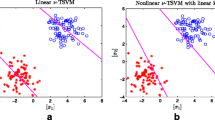Abstract
In this paper, a novel robust \(L_{1}\)-norm based twin bounded support vector machine with pinball loss- having regularization term, scatter loss and misclassification loss- is proposed to enhance robustness in the presence of feature noise and outliers. Unlike in twin bounded support vector machine (TBSVM), pinball is used as the misclassification loss in place of hinge loss to reduce noise sensitivity. To further boost robustness, the scatter loss of the class of vectors is minimized using \(L_{1}\)-norm. As an equivalent problem in simple form, a pair of quadratic programming problems (QPPs) is constructed (L1-Pin-TBSVM) with m variables where m is the number of training vectors. Unlike TBSVM, the proposed L1-Pin-TBSVM is free from inverse kernel matrix and the non-linear problem can be obtained directly from its linear formulation by applying the kernel trick. The efficacy and robustness of L1-Pin-TBSVM has been demonstrated by experiments performed on synthetic and UCI datasets in the presence of noise.




Similar content being viewed by others
References
Cortes C, Vapnik VN (1995) Support-vector networks. Mach Learn 20(3):273–297
Vapnik VN (2000) The nature of statistical learning theory, 2nd edn. Springer, New York
Guyon I, Weston J, Barnhill S, Vapnik VN (2002) Gene selection for cancer classification using support vector machine. Mach Learn 46:389–422
Joachims T, Ndellec C,.Rouveriol C (1998) Text categorization with support vector machines: learning with many elevant features. In: European conference on machine learning, No.10, Chemnitz, Germany, pp 137–142
Kim SK, Park YJ, Toh KA, Lee S (2010) SVM-based feature extraction for face recognition. Pattern Recogn 43(8):2871–2881
Cristianini N, Shawe-Taylor J (2000) An introduction to support vector machines and other kernel based learning method. Cambridge University Press, Cambridge
Osuna F,.Freund R,.Girosi F (1997) An improved training algorithm for support vector machines. In: Proceedings of the IEEE workshop on neural networks for signal processing, Amelia Island, FL, pp 276–285
Platt J (1999) Fast training of support vector machines using sequential minimal optimization, Advances in Kernel Methods-Support Vector Learning, MIT Press, Cambridge. MA, pp 185–208
Hsieh C-J, Chang K-W, Lin C-J (2008) A dual coordinate descent method for large scale linear SVM. In: Proceedings of the 25th international conference on machine learning, Helsinki
Mangasarian OL, Musicant DR (1999) Successive overrelaxation for support vector machines. IEEE Trans Neural Networks 10(5):1032–1037
Mangasarian OL, Wild EW (2006) Multisurface proximal support vector classification via generalized eigenvalues. IEEE Trans Pattern Anal Mach Intell 28(1):69–74
Jayadeva R, Khemchandani S (2007) Chandra, Twin support vector machines for pattern classification. IEEE Trans Pattern Anal Mach Intell 29(5):905–910
Balasundaram S, Gupta D, Prasad SC (2017) A new approach for training Lagrangian twin support vector machine via unconstrained convex minimization. Appl Intell 46:124–134
Kumar MA, Gopal M (2009) Least squares twin support vector machines for pattern classification. Expert Syst Appl 36:7535–7543
Peng X (2010) A ν-twin support vector machine (ν-TSVM) classifier and its geometric algorithms. Inf Sci 180(20):3863–3875
Peng X (2011) TPMSVM: a novel twin parametric-margin support vector machine for pattern recognition. Pattern Recogn 44(10–11):2678–2692
Peng X, Xu D, Kong L, Chen D (2016) norm based twin support vector machine for data recognition. Inf Sci 340–341:86–103
Shao YH, Zhang CH, Wang XB, Deng NY (2011) Improvements on twin support vector machines. IEEE Trans Neural Netw 22(6):962–968
Huang X, Shi L, Suykens JAK (2014) Support vector machine classifier with pinball loss. IEEE Trans Pattern Anal Mach Intell 5:984–997
Rastogi R, Pal A, Chandra S (2018) Generalized Pinball loss SVMs. Neurocomputing 322:151–165
Xu Y, Yang Z, Pan X (2016) A novel twin support-vector machine with pinball loss. IEEE Trans Neural Netw Learn Syst 28(2):359–370
Huang X, Shi L, Suykens JAK (2014) Asymmetric least squares support vector machine classifiers. Comput Stat Data Anal 70:395–405
Prasad SC, Balasundaram S (2021) On Lagrangian L2-norm pinball twin bounded support vector machine via unconstrained convex minimization. Inf Sci 571:279–302
Frenay B, Verleysen M (2014) Classification in the presence of label noise: a survey. IEEE Trans Neural Netw Learn Syst 25(5):845–869
Suykens JAK, Brabanter JD, Lukas L, Vandewalle J (2002) Weighted least squares support vector machine: robustness and sparse approximation. Neurocomputing 48(1):85–105
Mehrkanoon S, Huang X, Suykens JAK (2014) Non-parallel support vector classifiers with different loss functions. Neurocomputing 143:294–301
Yang L, Dong H (2018) Support vector machine with truncated pinball loss and its application in pattern recognition. Chemom Intell Lab Syst 177:89–99
Huang X, Shi L, Suykens JAK (2014) Ramp loss linear programming support vector machine. J Mach Learn Res 15:2185–2211
Shen X, Niu L, Qi Z, Tian Y (2017) Support vector machine classifier with truncated pinball loss. Pattern Recogn 68:199–210
Gao S, Ye Q, Ye N (2011) 1-norm least squares twin support vector machines. Neurocomputing 74:3590–3597
Yan H, Ye Q, Zhang T, Yu D-J, Yuan X, Xu Y, Fu L (2018) Least squares twin bounded support vector machines based on L1-norm distance metric for classification. Pattern Recognit 74:434–447
Yan H, Ye Q-L, Yu D-J (2019) Efficient and robust TWSVM classification via a minimum L1-norm distance metric criterion. Mach Learn 108:993–1018
Hao P-Y (2010) New support vector algorithms with parametric insensitive/margin model. Neural Netw 23(1):60–73
Peng X, Chen D, Kong L (2014) A clipping dual coordinate descent algorithm for solving support vector machines. Knowl-Bases Syst 71:266–278
Murphy PM, Aha DW (1992) UCI repository of machine learning databases. University of California, Irvine. http://www.ics.uci.edu/~mlearn
Demsar J (2006) Statistical comparisons of classifiers over multiple data sets. J Mach Lear Res 7:1–30
Acknowledgements
The authors are very thankful to the reviewers for their valuable comments which helped improve the presentation of the paper significantly.
Author information
Authors and Affiliations
Corresponding author
Ethics declarations
Conflict of interest
The authors have no relevant financial or non-financial interests to disclose.
Additional information
Publisher's Note
Springer Nature remains neutral with regard to jurisdictional claims in published maps and institutional affiliations.
Rights and permissions
About this article
Cite this article
Prasad, S.C., Anagha, P. & Balasundaram, S. Robust Pinball Twin Bounded Support Vector Machine for Data Classification. Neural Process Lett 55, 1131–1153 (2023). https://doi.org/10.1007/s11063-022-10930-6
Accepted:
Published:
Issue Date:
DOI: https://doi.org/10.1007/s11063-022-10930-6




